Introduction
Marcelo Bielsa’s philosophy, when in possession, works around breaking the defensive lines to progress the ball through the thirds. The Argentinian settles a rank of priorities when breaking lines, placing the ball beyond the back-line as the highest order. Facing the challenge of a compact defence, we see Bielsa’s team performing the “Up-Back-Through” combination to break the lines. This tactical action creates vertical pockets with a third man run that exploits the space created.
This tactical analysis piece, in the form of coaching/training analysis, will go through one coaching session on how to use the “Up-Back-Through” (U-B-T) combination to break the back-line. In this analysis, we will show how this concept is part of Leeds United’ tactics, applied in a wide range of situations in the Premier League.
Theory and game situations
Nowadays, even attacking-minded coaches of the likes of Jürgen Klopp set their squads in a compact block when out of possession. In a compact-block, the defensive lines do not allow any pockets to play between the lines. Against tight defences, the “Up-Back-Through” action break those lines vertically, without recurring to shifting the defence horizontally. As shown in the next picture, the U-B-T combination starts with a forward pass (UP) to a teammate who drops back, dragging his mark. The second part of the action is a lay-off (BACK) to a player facing forward who places the ball in the space created (THROUGH). There should be a third man run who exploits the area behind.
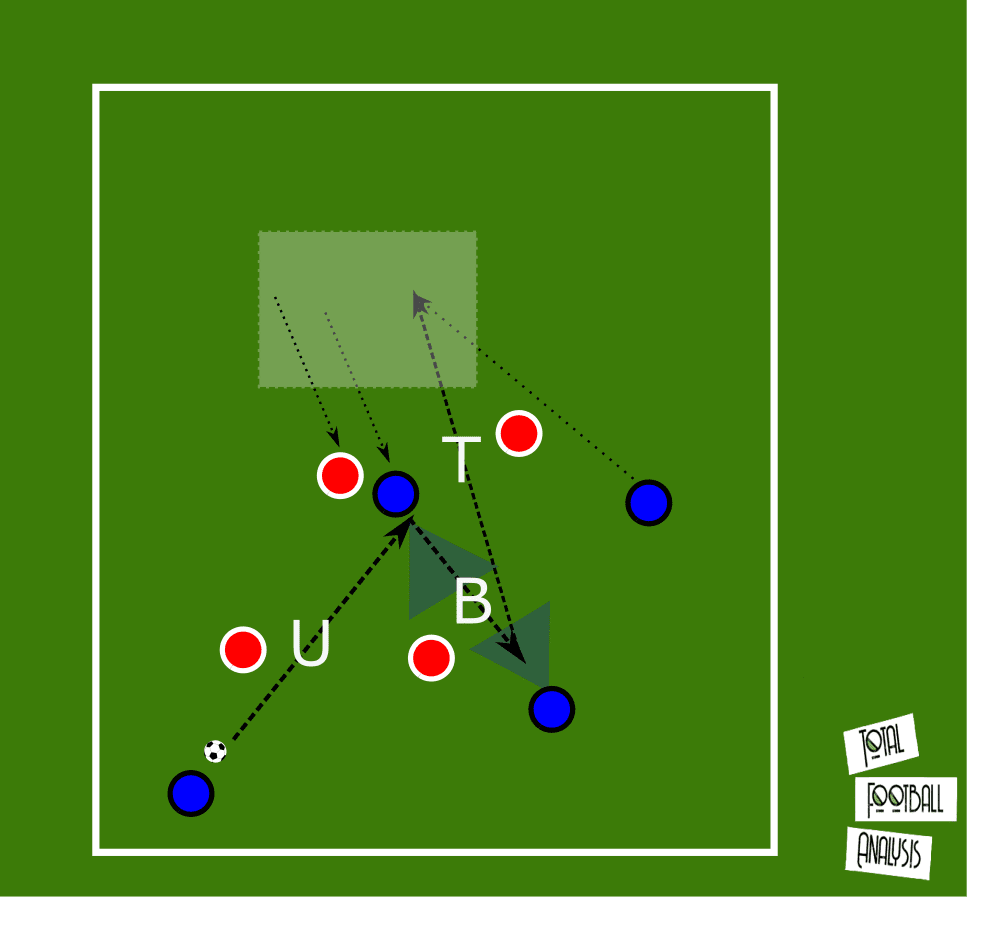
Bielsa’s teams develop this combination throughout the game, should the forward pass (UP) drag a defender out of position. Their teammates anticipate the play and place themselves for the back-through passes to collect the ball behind the lines. Analyzing a Leeds’ game, we can see that this action is a well-worked communication within the team. The next picture shows Leeds performing this tactical football action in the middle third, collecting the ball behind the full-back.
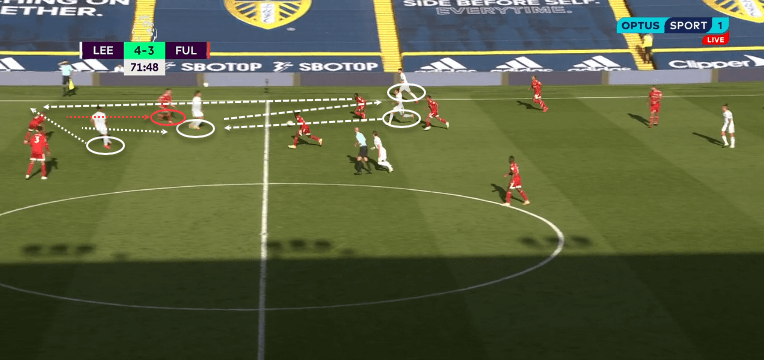
This action is a non-verbal communication performed by the whole team at any part of the pitch. For example, the next shot depicts this action used in the build-up on the defensive third. The keeper plays a long ball to the right flank (UP in yellow), who lays it off to the full-back (BACK in blue). The full-back plays a forward pass (THROUGH in green) for the inside-midfielder, making the third man run (white) to collect the ball behind the midfield line.
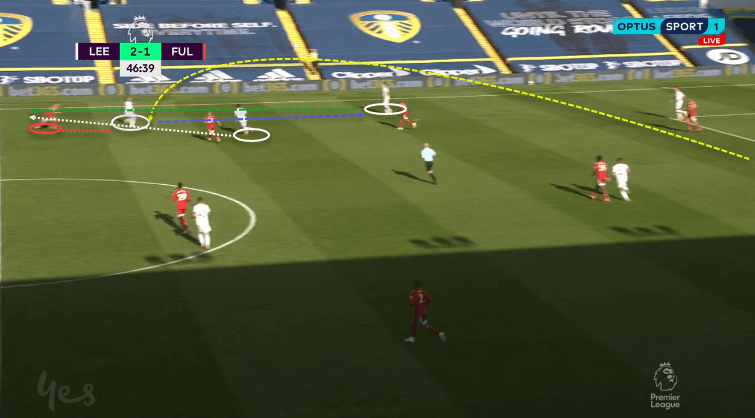
We want to highlight that many are the teams who use this action creating vertical pockets to break the lines. In a more transitional League as the Bundesliga, we analyzed this pattern mastered on the offensive transitions. In the next snapshot, we can see a goal scored by Bayer Munich using the U-B-T action to counter-attack. Once the centre-back recovered the ball, not in the picture, he passed it forward to the striker, who drops back. The opposite centre-back track the run falling out of position. The advanced midfielder plays an instrumental role in the action giving an option to the striker to lay-off the ball and anticipate the left-wing run behind the space created.
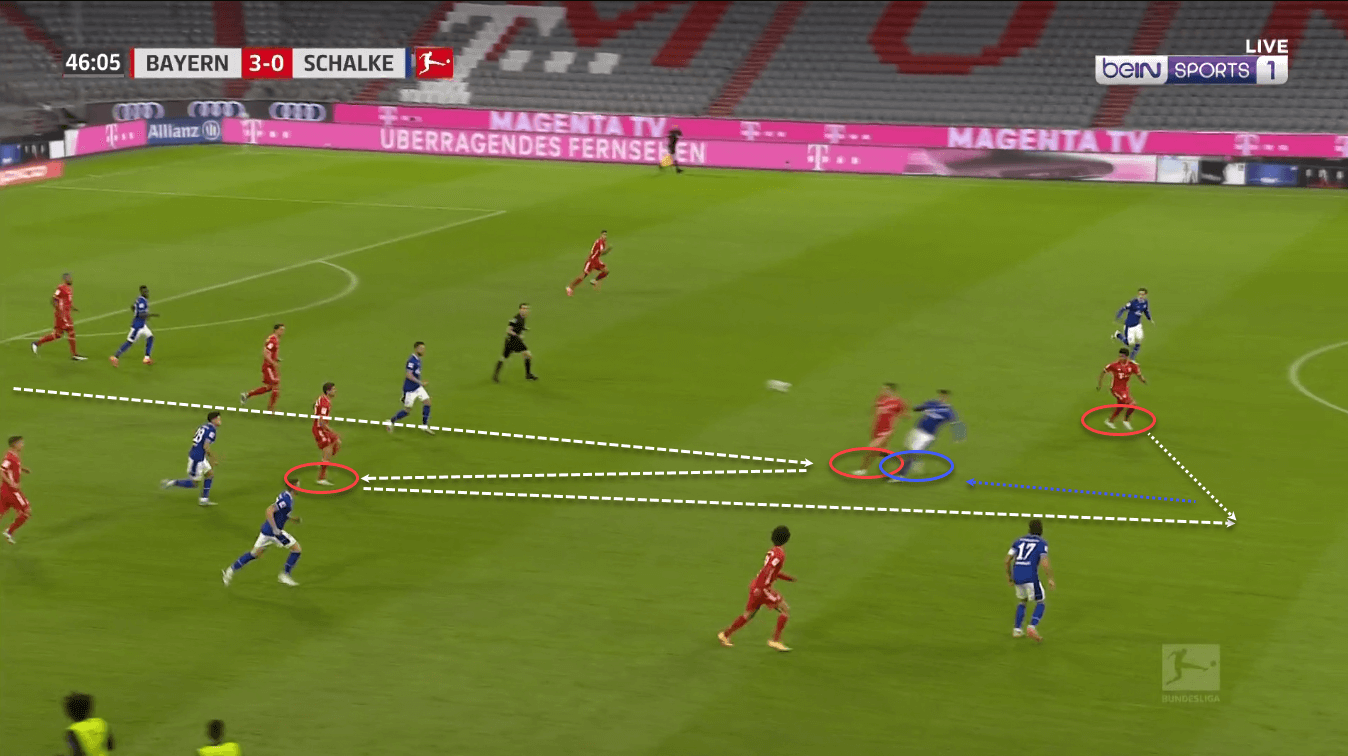
Training Session
As aforementioned, when breaking lines, the highest priority in Bielsa’s philosophy is to get the ball beyond the back-line. Should the U-B-T break the defensive line, it would generate a scoring opportunity. Having this in mind, when designing the session, we would situate the practice in the area where we want to accomplish the desired action. This training session will aim to create the “Up-Back-Through” combination to penetrate the back-line and create an opportunity on goal. We see an example of this action in the next shot. Manchester City used the U-B-T combination in the final third to score.
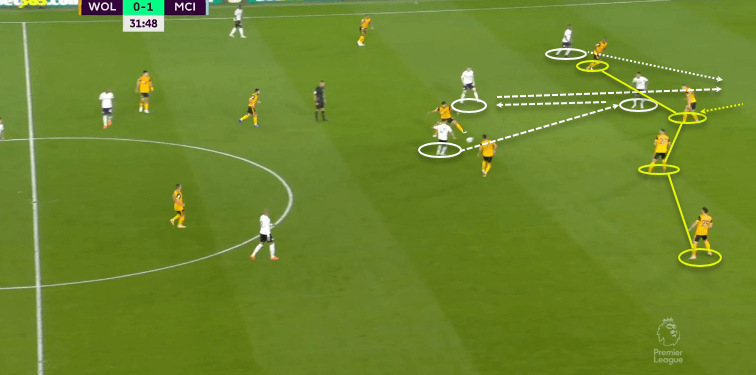
The training session will consist of three drills that we will present, finishing with a training game to assess the success of the session. We planned the session for 18 outfield players plus two goalkeepers joining the team from the third drill. We present the session as it flows chronologically, starting from the warm-up, albeit the session’s design began from the game training, where we exactly replicate the desired football situation.
Warm-up
For the first part of this session, we designed a 3+3v3 rondo in which we would focus on the third man concept building into the U-B-T action. Four players, two of each colour of the in-possession team, will be playing in the outside as depicted in the next diagram, different colours on opposite sides. The remaining two players would move freely inside the rectangle, marked by the three defenders. The constraint included in this rondo is that the player’s in-possession can only pass to the other colour. In this example, when blues have the ball, they can only pass to green. If one of the defenders recovers the ball or forces a mistake, the defender’s team switch with the team responsible for the unsuccessful action.
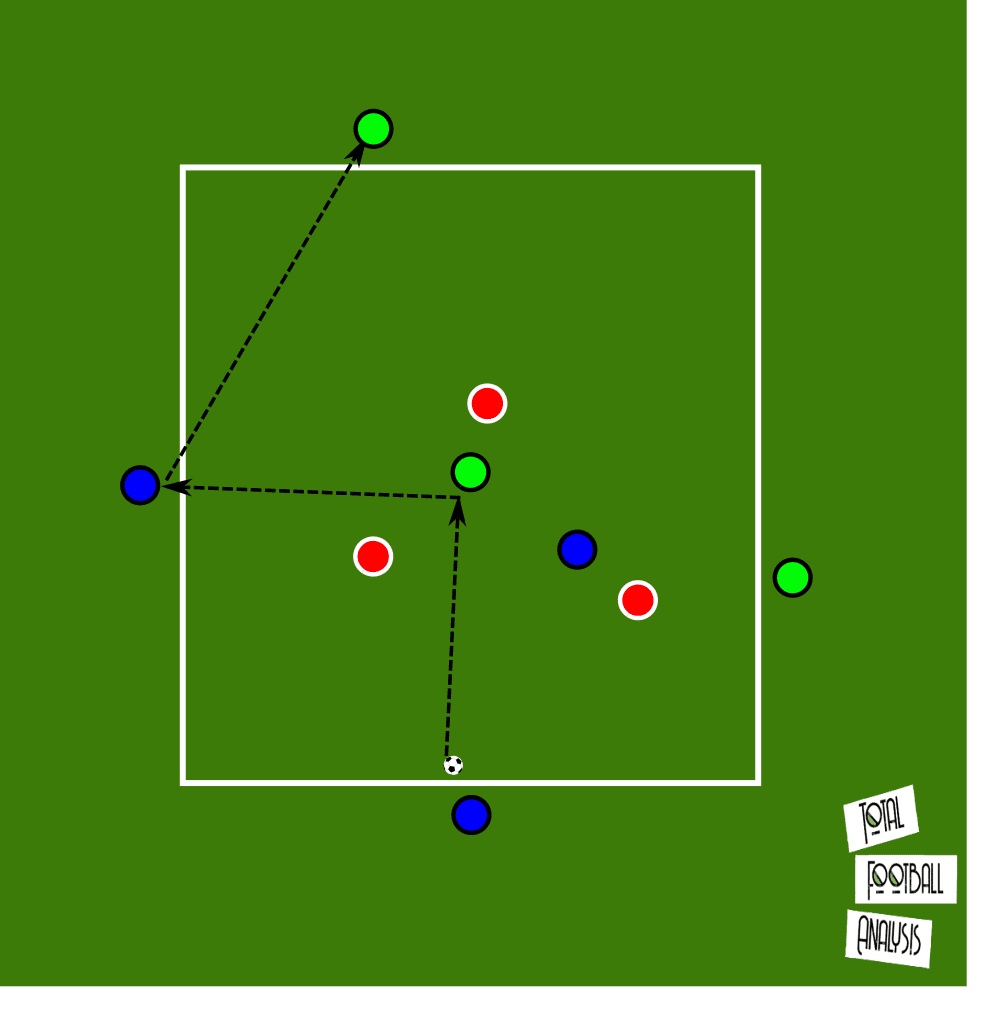
Rondos include communication, decision making, and execution of those decisions suiting perfect in the coaching theory. The colour constraint will overload the players on the third man concept, essential for accomplishing the desired U-B-T action. When a blue player has the ball, the blue teammates can not receive the ball. This constraint will force them implicitly to start anticipating the next pass and give options to the future receiver, in this case, the green players. The coach should support the implicit learning with positive feedback on the desired behaviours: off the ball movements, angle positioning, body shape, and weight on the passes to create the third man action.
To add a sense of direction and competition, we set a defensive punishment; if the team in-possession gets to play from the back player to the front and back again to the start, the defender team will have to win the ball twice. This rule provokes the principle of always trying to play forwards and not just passing for the sake of passing. We do not want to be stopping or overcoaching at this point in the session, albeit the design will create that competence in players to anticipate the play, giving an option to the other colour to progress the ball to the far end.
Once we see the drill progressing smoothly, we will give an extra incentive to the in-possession team to accomplish the U-B-T action implicitly. The in-possession team will be encouraged to make a central combination pass between their teammates. Should the in-possession colours combine centrally to get from back to front, it would be enough to punish the defenders for recovering the ball a second time. Under this reward, we would start seeing different central combinations. One possible outcome of breaking the lines would be the U-B-T action, as shown in the next diagram. Using a reward, we would be working on the desired football pattern in a real football situation.
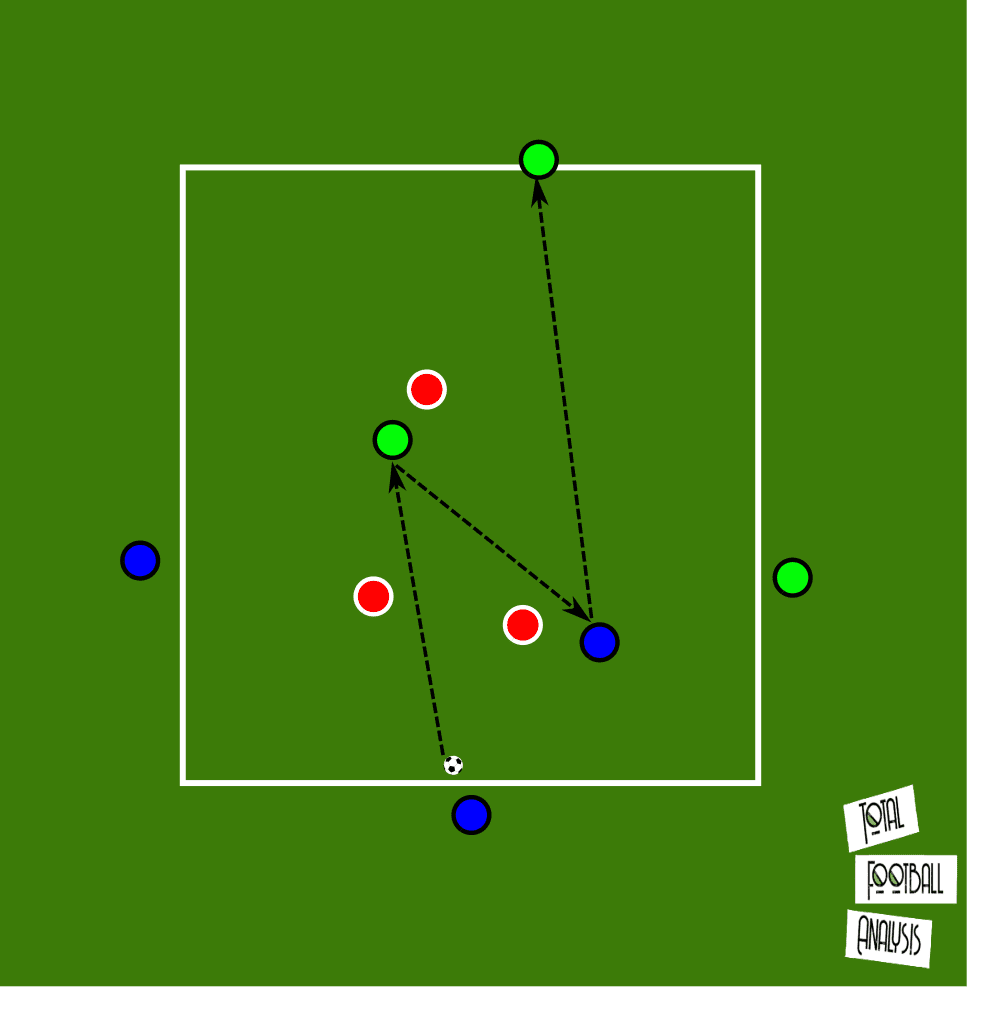
Positioning game
The second part of the session will be a positioning game, using 6v3 rondo played in two grids separated by a central zone. The ball will start in one of the grids in a 4v2 rondo, with the team in-possession positioned as shown in the next diagram with one player able to move freely in the inside of the grid. The team in-possession has to connect with the inside player in the central zone to progress the ball to the next grid. The side players would join the next grid with the inside player returning to the starting grid should the ball advance to the next grid. One defender will join the up-grid to create the 4v2. The teams will have the same task once the ball is in the up-grid, to return the ball to the bottom grid.
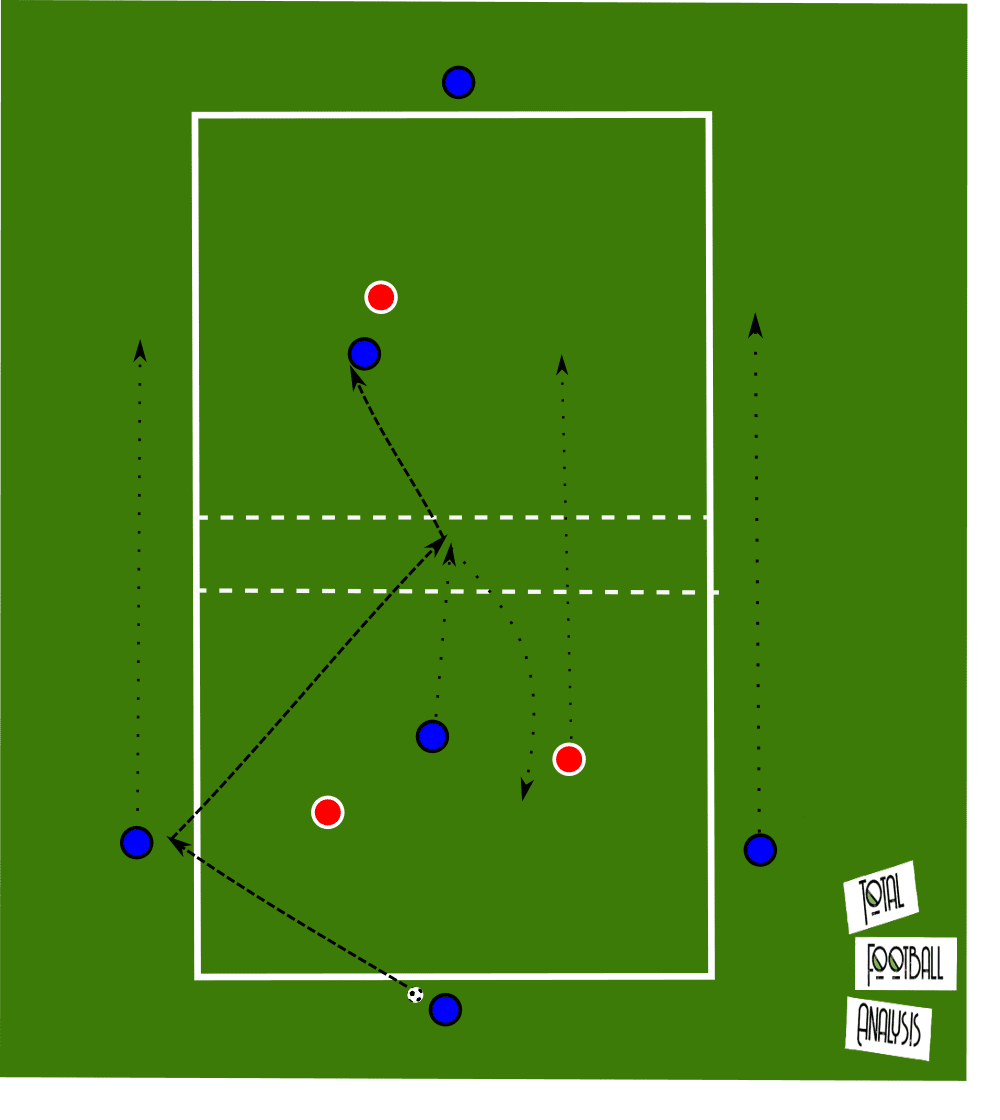
Once defenders start reading the game, they will begin marking the inside player closely as it is the one who can progress the ball to the other end. At this time, we will introduce a progression allowing the player in the grid above to drop to the central zone, the defender can follow. The constraint included in this progression is that players are allowed only one-touch in the central area. Any player in the bottom grid would be allowed to progress the ball to the next grid if the up teammate bounces it from the central zone, as shown in the following diagram.
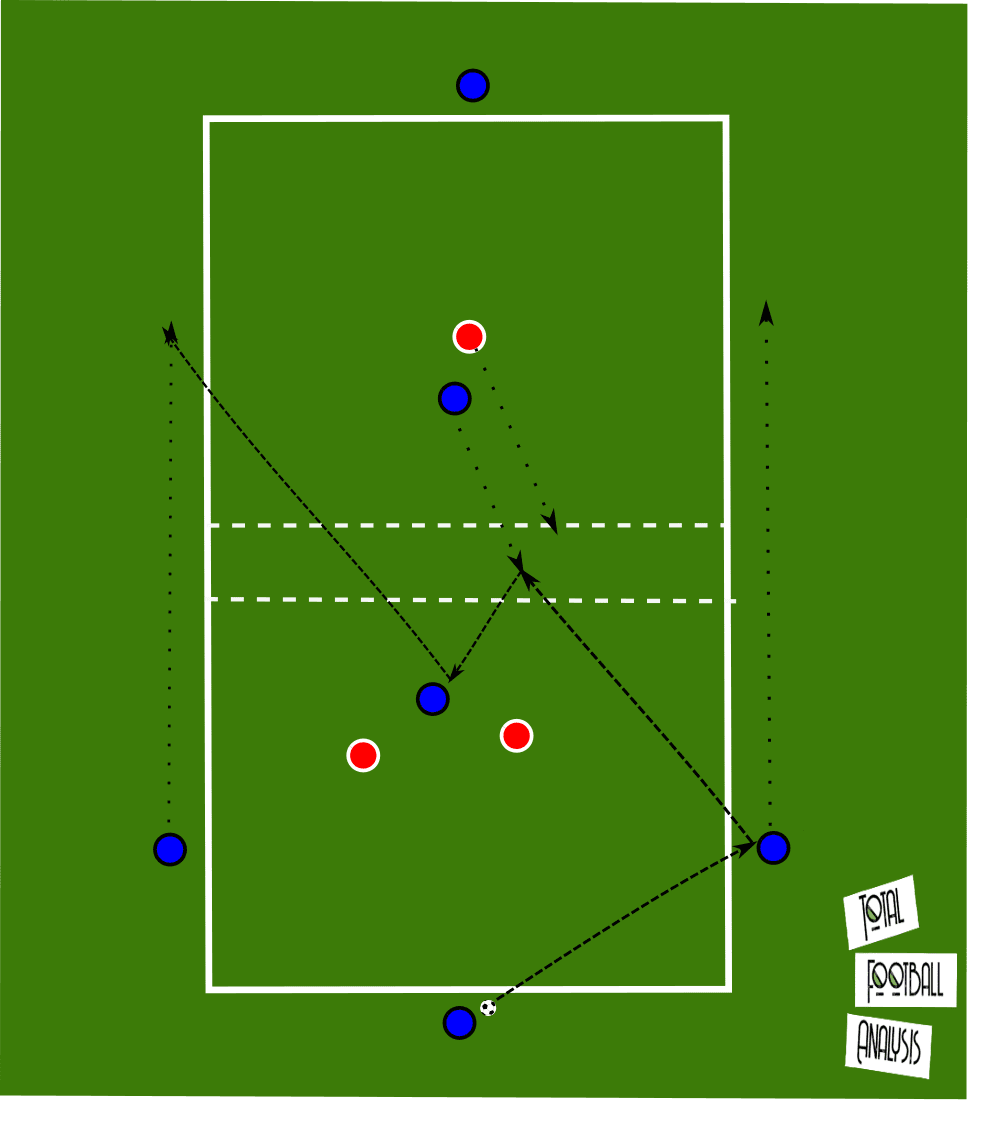
Players should start the rondo resembling their positioning in the game-specific situation that we are willing to replicate. The end and start players should be holding midfielders or centre-backs. The player inside should be advanced midfielders or strikers as they will be working on the back-through action. The side positions could vary from wings to full-backs, doing the third man run. With this said, players should change positions to work in different aspects of the action. Defenders will need to make a safe pass between their team to count as a recover ball. Under this constraint, players need to react counter-pressing, increasing the intensity.
In this part, the coaching points would guide the players in their decision making to progress the ball using the desire U-B-T action. The high positioned player should anticipate the play dropping to receive the forward pass, and players underneath the ball should be ready to play the through ball. The coach should guide players on their passes, working on the weight and direction of the lay-off and through ball. Finally, the wide players should be encouraged to time their runs, using the offside rule with the central zone. The coach should reinforce the coaching points once the players have experienced the game-specific situation creating consciousness of their competence.
Game Training
The third drill is the central part of the session, where we want to work on the concept of “Up-Back-Through” in the specific situation we planned. The game training would be a constraint game 9v9+GKs. The design will help to overload players in the communication to accomplish the desire tactical action progressing the ball behind the defensive line. The game training will position the players in the middle third, with the coaching side set in a 3-3-3 (resembling the used 4-3-3 with only one centre-back) against a compact 4-4-1.
We want to challenge the team to break the lines without creating horizontal gaps. To make this scenario, we will only use the central channel and the half-spaces, eliminating the wide lanes. The blue team will start with the ball from the centre-back in the halfway line. To score, they will first have to progress the ball through the blue dotted line, either by dribbling or passing. Should they achieve this, only one defender will be able to defend beyond the line. If the red team wins the ball, they will have 10 seconds to score on the opposite goal, first by dribbling or passing through the red line. Only one blue defender can follow beyond the line. The time-constraint forces the red team to transition fast, giving more time to work with the coaching team. Simultaneously we implicitly work on the fast defensive and offensive transitions principles in both groups.
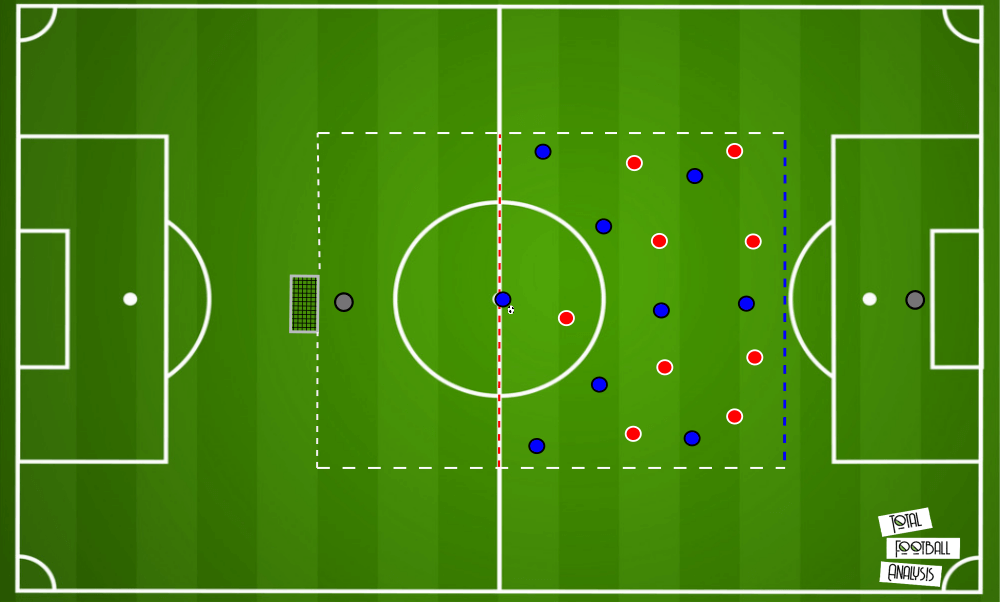
This session aims to progress the ball beyond the defensive line using the U-B-T action, as depicted in the next shot. In this drill, the coach would reinforce all the concepts mentioned in the previous exercises, focusing mainly on the tactical concepts of the idea. Forward players should drop to drag their marks out of position. Players underneath the dropping player should position themselves, giving an option to receive the ball and play through balls. Players not involved in those actions should anticipate the movement and time their runs to be on-side and exploit the vertical gaps left in the defensive line. Players should be encouraged to work on the different roles of the action. Should the wing drop to receive the pass from the full-back, the holding midfielder should position to receive the back ball, and the striker will be the one exploiting the space behind the full-back, alternating roles. Although the session aims to use the U-B-T combination, the coach would encourage players to be creative to break the lines using different football actions.
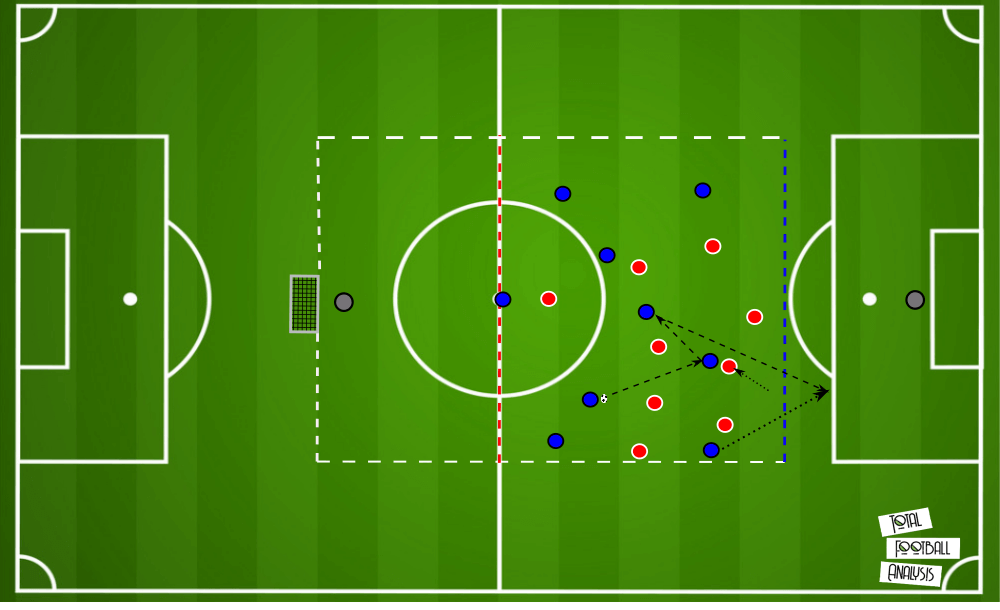
Conclusion
This session would finish with a regular game where the players play competitively and freely. In this part of the session, the coach should assess the success of it, determining whether the players can independently apply what they have learned in the earlier parts.
Through this session, we have gone through one of the concepts more frequently use to break the lines by Bielsa at Leeds United. A valuable idea to break the lines shared by many coaches, as shown before. There is no one way to break the lines; this tactical action should not limit the players, but give them an extra tool when facing a compact block.





Comments